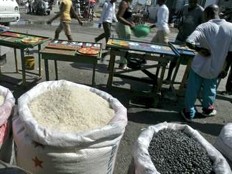|
||||||||||||||||||
|
|
Haiti - Agriculture : Perspectives on Food Security 2011 13/02/2011 15:52:40
The current level of food prices, particularly rice, exceeds that of 2008. With annual average variations of almost 10% and 11%, the local rice and red beans are the products whose price is more varied. These prices have progressed to reach their level post-earthquake, where in less than one month they were selling at 15-20% more expensive compared to December 2009. Rising prices will have negative impacts on food security of poor households who, for feed themselves, buy on regular market. January to March is the period where the food prices will show a clear upward trend. According to the five year average, calculated on the reference markets between January and May, the prices of black beans increased about 12%, rice by about 5% and those of maize flour from 15 to 20%. The metropolitan area of Port-au-Prince 80% of money circulating in Haiti is located in the metropolitan area of Port-au-Prince. Also, poor and very households poor, especially those living in slums and camps, depend almost entirely of the market as a source on food and labor. These households are highly vulnerable fluctuations in the price (increase), Nearly a third of the population of the metropolitan area, 900,000 people, was estimated as food insecure in June 2010. But since October the food security conditions tend to worsen with cholera and Hurricane Tomas. In mid-January 2011, the most basic foodstuffs have recorded prices above of those of 2010 for the same period. For example, the price of rice is about 38% higher than the five year average and about 27% higher than January 2008. Products from areas affected by Hurricane Tomas, including yams and bananas, followed the same trend because of low production. The Artibonite Valley and Lower Central Plateau According to the study conducted by the CNSA on the influence of cholera on food security, we observe a decrease of almost 30% compared to the average of labor in the Artibonite Valley and in the irrigated areas in the Central Plateau. Between 10 to 15% of the rice harvest could not occur for lack of workers. There is also a decline in demand for products from the Valley, particularly horticultural products. In front of the rising cost of production due to the rarity of labor and the declining demand for agricultural products from the Artibonite, the producers reduce the amount of cultivated land. The area planted in December / January for the winter season is lower by almost 30% compared to the area used during the previous season. The poor households in the area, that will respond to the lower demand for the products of Artibonite by looking for opportunities of local agricultural labor instead of own production, will have enough income to meet their food needs. Other poor households will need assistance to meet their nutritional needs. It is likely that in these conditions, to reach a level of malnutrition greater than the seasonal average especially between March and May. South Peninsula Cyclone Tomas, besides infrastructure, has affected agriculture and fishing. The number of people engaged in these activities is estimated at 452.255, ± 40% of the population, particularly in the communes of Chardonnière, Anglais and Tiburon in the Southern Department and those of the Irois and the Dame Marie in Grand Anse. The poor and very poor who represent over 50% of the population, live of agricultural activities. They buy almost 80% of their food and are highly vulnerable to the price increase planned for April/May due to a decrease of the offer but also because of the social and political unrest that have affected the movement of goods and services in December. Particular additional suppositions for this area are : That harvests of sorghum and bean expected for February and March will be about 30% lower than expected harvest before Hurricane Tomas. The decline in demand for fish has reduced the price of fish up to 60% immediately after the onset of cholera. With the information campaigns we see a resumption of fishing activities and consumption of seafood [Fishing contributes from 20 to 25% in income of households in coastal areas] Between March and April, we can expect an intensification of timber for charcoal production, a common strategy that makes the area even more vulnerable to bad weather. The poor and very poor will also intensify the emigration, these two strategies will be insufficient to meet the food needs of the poor who have to deal with the decline of production; the decline of the income from fishing and the increase more pronounced than usual of the prices of food products. See also: https://www.haitilibre.com/en/news-2287-haiti-argentina-food-self-sufficiency-soon-a-reality-in-haiti.html https://www.haitilibre.com/en/news-2085-haiti-agriculture-fao-to-the-rescue-of-rural-populations.html HL/ HaitiLibre
|
|
|
Why HaitiLibre ? |
Contact us |
Français
Copyright © 2010 - 2024 Haitilibre.com |



